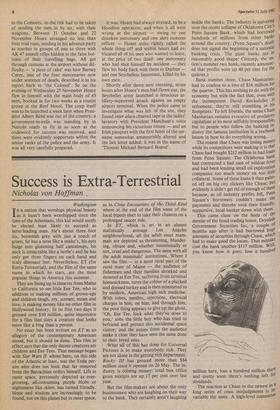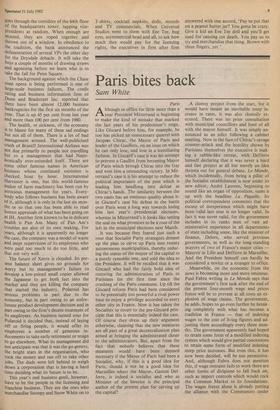Success is Extra-Terrestrial
Nicholas von Hoffman
Washington
In a nation that worships physical beauty as it hasn't been worshipped since the time of the Athenians, this kid would surely be elected least likely to succeed as hero/leading man. He's about three foot six, brownish grey with just a touch of green, he has a nose like a snake's, his eyes bulge into glistening half cantaloups, his neck is retractable like a turtle's and he has only got three fingers on each hand and scaly dinosaur feet. Nevertheless, ET (for Extra-Terrestrial), and the film of the same name in which he stars, are the most popular things in America this summer.
They are lining up in theatres from Maine to California to see little Eee Tee, who in addition to making millions of grown-ups and children laugh, cry, scream, moan and love, is making money like no other film in Hollywood history. In its first two days it grossed over $10 million, quite impressive for a film that stars a creature that looks more like a frog than a person.
No essay has been written on ET as an allegory of the contemporary American mood, but it should be done. This film in effect says that the only decent creatures are children and Eee Tees. That message began with Star Wars II whose hero, on this side of the Atlantic at least, was the Yoda per- son who does not look that far removed from the Batrachian orders himself. Life in outer space, previously depicted as ever- growing, all-consuming purple blobs or nightmares like Alien, has turned friendly. Hope and wisdom are increasingly to be found, not on this planet but in outer space, as in Close Encounters of the Third Kind where at the end of the film some of the local bipeds elect to take their chances on a prolonged saucer ride.
In ET, which is set in an almost
statistically average Los Angeles neighbourhood, all the adult erect mam- mals are depicted as threatening, blunder- ing, obtuse and, whether intentionally or not, cruel and dangerous. The same with all the adult mammals' institutions. Where I saw the film — in a most rural part of the rural state of Maine — the audience of fishermen and their families shrieked and moaned as Eee Tee, suffering from terminal homesickness, turns the colour of a plucked and dressed turkey and is then ministered to by modern, American high tech medicine. With tubes, needles, injections, electrical charges in him, on him, and through him, the poor thing appears to give up the ghost. 'Oh, Eee Tee, look what they've done to you,' sobs the little boy who has tried to befriend and protect this accidental space visitor; and the noises from the audience make it clear they have seen the same done to their loved ones.
What all of this has done for Universal Pictures is to make everybody rich. They are not alone in the getting rich department. Rocky III has grossed more than $84 million since it opened on 26 May. The in- dustry is coining money: total box office gross receipts are up 17 per cent over last year.
But the film-makers are about the only businessmen who are laughing on their way to the bank. They certainly aren't laughing
inside the banks. The industry is quivering over the recent collapse of Oklahoma City's Penn Square Bank, which had borrowed hundreds of millions from other banks around the country. (Penn Square's death does not signal the beginning of a national banking crisis. The giant banks are 11 reasonably good shape: Citicorp, the na- tion's number two bank, recently announc- ed that profits were up 40 per cent for the quarter.) Bank number three, Chase Manhattan, had to confess to a loss of $16 million for the quarter. This has nothing to do with the economy but with the fact that, even with the incompetent David Rockefeller in retirement, they're still stumbling in his footprints. To left liberals, the name Chase Manhattan remains evocative of predatorY capitalism at its most selfishly irresponsible, but to people who follow the banking in- dustry the famous institution is a textbook lesson in how to do everything wrong.
The reason that Chase was losing money while its competitors were making it is that Chase had bought $212 million in bad loans from Penn Square. The Oklahoma bank had contracted a bad case of wildcat fever and had been lending small oil exploration companies too much money on too little collateral. Some of these loans it then palm- ed off on big city slickers like Chase, hot evidently it didn't get rid of enough of their because, as oil industry profits fell, Penn Square's borrowers couldn't make the payments and thereby took their friendly' supportive, local banker down with their'. This came close on the heels of the demise of the bond trading house, Drysdale Government Securities Inc, a couple of months ago after it had borrowed huge amounts of securities through Chase, which had to make good the losses. That mistake cost the bank another $117 million. Well' you know how it goes: lose a hundred million here, lose a hundred million there and pretty soon there's nothing left h)r dividends.
The reaction at Chase to the newest in 3 long series of crass misjudgments is in- variably the same. A high-level committee
goes through the corridors of the 64th floor of the headquarters tower, tapping vice- presidents at random. When enough are secured, they are roped together and thrown out of a window. In obedience to the tradition, the bank announced the defenestration of several VPs the other day for the Drysdale debacle. It will take the boys a couple of months of drawing straws and agonising before we learn who is to take the fall for Penn Square.
The background against which the Chase soap opera is being performed is one of large-scale business failures. The credit rating and business information firm of Dunn and Bradstreet Inc. reported that there have been almost 12,000 business bankruptcies for the first six months of the Year. That is up 45 per cent from last year and more than 100 per cent from 1980.
The health, or sickness, of the economy ,15 to blame for many of these sad endings but not all of them. There is a lot of bad management around. The well-publicised crash of Braniff International Airlines was not due primarily to people not travelling but to a management that had Napo- leonically over-extended itself. There are some other famous names in American business whose continued existence is Checked hour by hour. International Harvester is one, but this world-famous maker of farm machinery has been run by atrocious management for years. Every- body who follows business has been aware of it, although it is only in the last six mon- ths or so that one has been able to read honest appraisals of what has been going on at IH. Another firm known to be in delicate health is Pan Am. Many of Pan Am's troubles are also of its own making. For Years, although it is apparently no longer the case, the company was a model of waste and inept supervision of its employees who were paid too much to do too little, and that not very well.
The future of Xerox is clouded. Its pre- sent balance sheet gives no grounds for worry but its management's failure to develop a low-priced small copier allowed the Japanese to get both feet into the market and they are killing the company that started the industry. Polaroid has serious problems in part due to the economy, but in part owing to an unfor- tunate product development decision and in Part owing to the firm's decent treatment of us employees. As business turned sour for Polaroid it decided that, instead of laying off or firing people, it would offer its employees a number of generous in- ducements to take early retirement or resign to go elsewhere. What its management did not anticipate was that it was the go-getters, the bright stars in the organisation, who took the money and ran off to take other jobs. The duds were left behind to weigh down a corporation that is having a hard time deciding what its future is to be.
This year's real business genii, however, have to be the people in the licensing and franchise business. They are the ones who merchandise Snoopy and Snow White on to T-shirts, cocktail napkins, dolls, records and TV commercials. When Universal Studios went to them with Eee Tee, bug eyes, asymmetrical head and all, to ask how much they would pay for the licensing rights, the executives in firm after firm answered with one accord, 'Pay to put that on a peanut butter jar? You gotta be crazy. Give a kid an Eee Tee doll and you'll get sued for causing cot death. You pay us to try and merchandise that thing. Brown with three fingers, yet.'







































 Previous page
Previous page